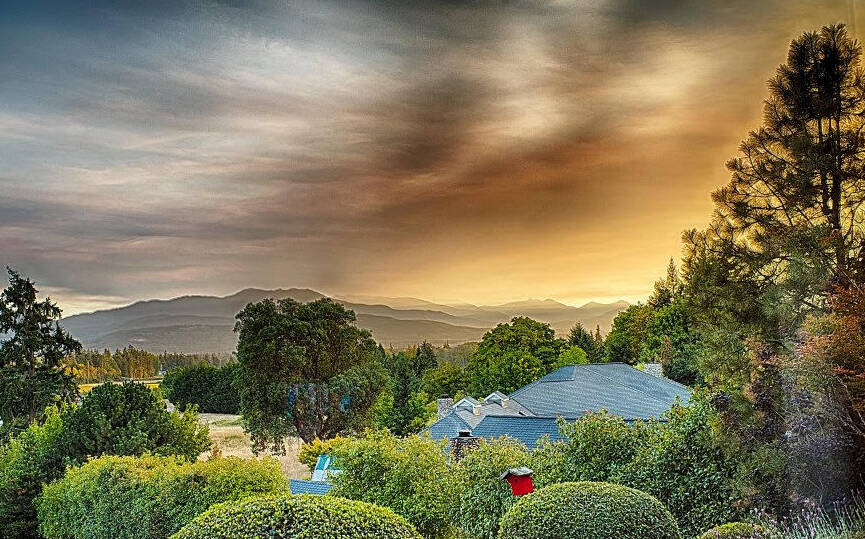Wildfires ignited by lightning last month in Olympic National Park swelled during a huge growth spurt this weekend, prompting the closure of more trails in the park while winds brought a smoke haze to the lowlands as well as ash to some areas of the North Olympic Peninsula.
The most impressive increase was reported Saturday (Sept. 16). The Delabarre Fire in the Delabarre Creek drainage in the south-central portion of the park — which just last week was only about 1 acre in size — exploded into an estimated 1,500 acres by Sunday afternoon, said Amos Almy, park spokesperson. Smoke obscured the perimeter and so it was difficult to get an accurate number, he added.
Warm temperatures and low relative humidity pushed the spread of the Delabarre Fire to the northeast over the ridge and into the Buckinghorse Creek drainage. Winds from the south carried embers to various spots, contributing to the rapid expansion of the blaze, Almy said.
Smoke seeped into the lowlands and led to reports of not only smoke but also ash — something few residents have seen from park wildfires — on Deer Park and Lost Mountain roads and even in downtown Sequim.
Much of that smoke apparently is from the Low Divide Fire in the North Fork Quinault drainage, estimated at 274 acres on Sept. 17.
The smoke settles into the Elwha Valley at night and during the day has been seen lifting north and northeast over the mountains toward Port Angeles, Sequim and into the Strait of Juan de Fuca, park officials said.
Despite the visual confirmation of the presence of smoke, the Olympic Region Clean Air Agency and others that monitor air pollution say air quality in Clallam and Jefferson counties is good.
The Obstruction Point Road and the trailhead have been closed due to the Eagle Point Fire since late August, but as of Saturday, more trails have been closed to public access.
They are the Elwha River Trail from Elkhorn to Low Divide, the Hayden Pass Trail, the Dosewallips River Trail from Dose Meadows to Hayden Pass and the Dodger Point Way Trail; North Fork Quinault Trail from Elip Creek trail junction to Low Divide; Skyline Trail from Elip Creek Trail junction to Low Divide; and Martin Park Trail.
Seven fires are burning in the park now. In addition to the Eagle Point Fire, estimated at 123 acres, and the Delabarre Fire and Low Divide fires, there are the Hurricane Fire at Hurricane Ridge, 4 acres; the Diamond Mountain Fire, 3.3 miles northeast of Anderson Pass, 30 acres; Martins Lake, 2 miles northeast of Mount Christie, 93 acres; and Mount Queets Fire at the summit of Mount Queets, 4 acres.
Park fire officials continue to maintain their mostly hands-off strategy to the fires since none threaten critical infrastructure or communities with some changes, although it has 50 fire personnel operating for all the wildfires.
Because of the smoke swirling into communities, additional “control and confine” tactics are being used on the Eagle Point Fire to keep the smoke down, Almy said.
Also, fire managers are ordering additional resources to manage and support firefighters on the ground, according to a park press release. A Type 3 incident management organization will be established to allow for more firefighters and helicopters, it said.
Overall, fires will be allowed to burn themselves out. The Delebarre Fire, for instance, although large, is in a very remote area.
“We can protect structures and keep people out, but otherwise, it’s burning a lot of understory brush and clearing out trees and snags,” Almy said.
“Fire is an integral part of the forested ecosystems on the Olympic Peninsula,” officials said in a press release.
“Plants and animals here have evolved with fire for thousands of years. Many factors such as weather, topography, and vegetation influence fire behavior and the effects that fires have on natural resources.”
There was a potential for showers Sunday night and into today, the park said.
In a joint press release issued Friday, the Olympic National Park and Olympic National Forest announced the lifting of temporary campfire restrictions and were allowing campfires in accordance with standard rules and regulations. This is due to favorable weather conditions and seasonal changes, officials said.



